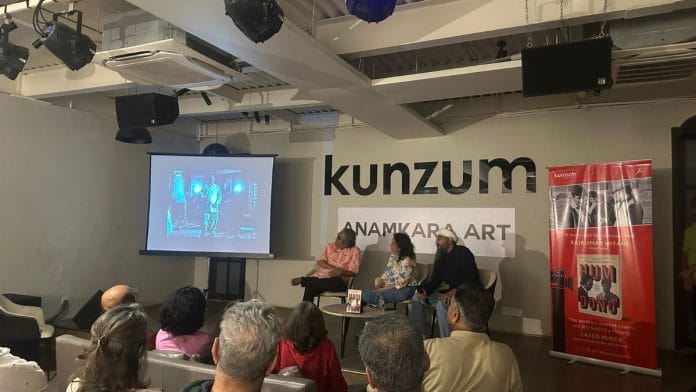New Delhi: Filmmaker Vijay Anand aka ‘Goldie’ and Dev Anand taught an entire generation to handle heartbreak with grace, long before we even knew that was possible, said film buff and graphic designer Bobby Singh at a recent talk on the book Hum Dono by Tanuja Chaturvedi.
In the warm April light of Kunzum Bookstore in Delhi, amid bold abstract art, the audience were drawn from postmodern chaos into a quieter, black and white world—the cinematic universe of Dev and Goldie Anand.
One of the standout discussions of the evening centred on Goldie’s refusal to spoon feed his audiences. His films, Singh said, demanded attention—they trusted the viewer’s intelligence.
Against the backdrop of Kunzum’s postmodern art lined walls, Chaturvedi’s book Hum Dono invited the audience into a world of monochrome celluloid dreams—unmistakably cinematic and achingly familiar.
The event opened with an aptly witty line by writer and editor Shantanu Ray Chaudhuri who was the host for the evening. “Hum Dono will be discussed by Hum Teen,” said Chaudhuri, referring to himself, Chaturvedi, and film buff Bobby Singh. But it was Chaturvedi’s voice that held the room in rapt attention, not just as an author but as someone who had lived and breathed the world she wrote about—working closely with Navketan Films and its many legends.
Also read: Dil Hi Toh Hai was a ‘Muslim social’ — but it put insaniyat and sharafat above khandan
Who directed Hum Dono?
A lifelong cinephile, Chaturvedi recalled watching the 1965 film Guide 12 times at Daryaganj’s Golcha Cinema with her cousins. At the age of five, she met Dev Anand at the premiere of Pyaar Mohabbat, where he picked her up in his arms and affectionately called her “little gypsy.”
“It was terrifying in a way,” she laughed. “I couldn’t believe someone I only saw on screen could be real. I was starstruck.”
If Dev Anand was the eternal romantic, courtly and dream eyed, then Goldie was the architect of cinematic rebellion: a Bombay bred cosmopolitan who refused to shoot love straight, elevating the grammar of Hindi cinema without ever needing a manifesto.
“Of course Rosie had to come from him—only a director who had seen complex, difficult women could have given us a character so unapologetically ahead of time.” said Chaturvedi.
Chaturvedi painted a portrait of Dev Anand as the gentleman of Indian cinema, a man whose touch, according to his heroines, never once crossed the invisible line of discomfort. “Asha Parekh, Waheeda Rahman—they all said the same thing,” she recalled. “With Dev, you knew you were safe.”
Vijay Anand, emerged as the auteur in his own right. “Why do film families always begin and end with the Kapoors?” Bobby Singh on the panel mused. The Anand brothers, it was suggested, were not only equal players in the evolution of the Golden age of reel, they were its most daring pioneers.
The question of who truly directed Hum Dono—credited to Amarjeet surfaced too. Chaturvedi, in her gut, believes it was Goldie. “Only he could create that kind of narrative tension, that cinematic silence,” she said, referencing the film’s unforgettable opening: the first seven minutes unfold in complete silence, until the spell is broken by the strains of Abhi Na Jao Chhod Kar, a song that seeps into your blood.
From revolutionary song picturisations where Goldie cut shots during the melody rather than the beat to his genre inverting triumphs like Tere Ghar Ke Saamne, “Goldie was an editor’s dream and a director’s rebellion,” Chaturvedi said with admiration. “In true Goldie fashion, the climax was sometimes the first thing he shot…he liked to begin where most directors end.”
Also read: Trishul tested Amitabh Bachchan’s emotional range—and he was more than an angry young man
Risk, rhythm, reckoning
What lingered in the room wasn’t just reverence, it was a knowing nod to something deeply felt. The kind that comes from Chaturvedi quoting lines like “Jhagda niptane ke do tareeke hain : ek Cheeni tareeka, ek Hindustani tareeka (There are two ways to settle a dispute: the Chinese way, and the Indian way),” from Tere Ghar Ke Saamne, a film released in 1963, just months after the India-China War. At a time when the nation was still processing its bruised morale, the Anand brothers managed to carry the weight of post-1962 Nehruvian optimism through a cinematic banter.
Goldie’s magnum opus—Guide wasn’t just ahead of its time, it ignored the clock altogether. Once shrugged off as too niche for Indian audiences, it went on to become a transnational phenomenon. At a time when Hindi cinema was still playing safe with virtue and villainy, Guide dared to center a morally complex woman, flirt with spiritual angst, and let its songs carry the weight of inner conflict. Unlike anything mainstream Bombay Talkies had seen, it was storytelling with risk, rhythm, and reckoning, and it worked.
Among the audience were keen listeners like Arun Kumar, a chef and filmmaker. “The techniques we now applaud in Adolescence—the stylized shots, the choreography—Goldie was already doing decades ago in his song and dance sequences,” he said.
Amrita Bhalla, an associate professor at JMC, found feminist liberation in a single refrain. “Aaj Phir Jeene Ki Tamanna Hai,” she said, “That line still hits with the same urgency today.”
As the lights dimmed and signed copies of Hum Dono passed hand to hand. Someone in the crowd whispered, “You know, Dev saab would have loved this. And Goldie saab would’ve complained about the sound system.”— not because there was anything wrong, but simply because perfection was his baseline.
(Edited by Theres Sudeep)






